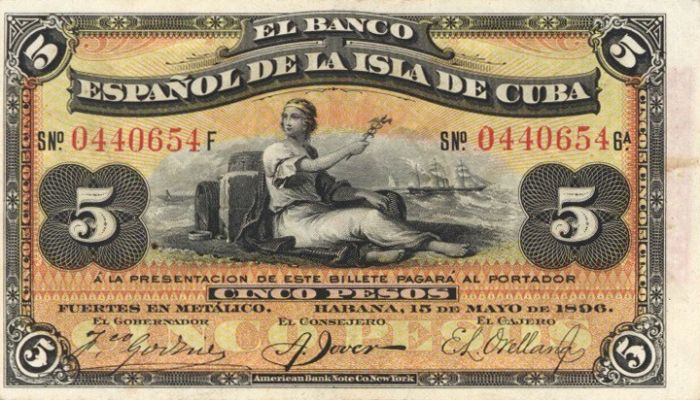Cuba - P-45b - 5 Pesos - Foreign Paper Money
Inv# FM2447 Foreign Paper Money
5 Pesos, P-45b.
The Cuban peso (in Spanish peso cubano, ISO 4217 code: CUP) also known as moneda nacional, is the official currency of Cuba.
The Cuban peso historically circulated at par with the Spanish-American silver dollar from the 16th to 19th centuries, and then at par with the U.S. dollar from 1881 to 1959. The Castro government then introduced the socialist planned economy and pegged the peso to the Soviet ruble.
The Soviet Union's collapse in 1991 resulted in a Special Period of difficult economic adjustments for Cuba. From 1994 to 2020 the Cuban peso co-circulated with the Cuban convertible peso (ISO 4217 code "CUC"; colloquially pronounced "kook" in contrast to the CUP, often pronounced "koop"), which was convertible to and fixed against the U.S. dollar, and which was generally available to the public at a rate of US$1 = CUC 1 = CUP 25. State enterprises under the socialist planned economy, though, were entitled to exchange CUPs into CUCs and U.S. dollars at the official, subsidized rate of US$1 = CUC 1 = CUP 1, within prescribed limits.
From 1 January 2021 Cuba implemented the so-called "Day Zero" of monetary unification which abolished the Cuban convertible peso as well as the 1 CUP/USD rate for state enterprises. Henceforth the Cuban Peso became the only legal tender in Cuba, CUCs were converted at the rate of 24 CUP/CUC, and a single official exchange rate of 24 CUP/USD became applicable for both public and private transactions.
Before 1857, Spanish and Spanish colonial reales circulated in Cuba. From 1857, banknotes were issued specifically for use on Cuba. These were denominated in pesos, with each peso worth 8 reales. From 1869, decimal notes were also issued denominated in centavos, with 100 centavos for each peso. In 1881, the peso was pegged to the US dollar at par. The currency continued to be issued only in paper form until 1915, when the first coins were issued.
In 1960, the peso lost value after the United States imposed an embargo against Cuba and the suspended the sugar quota. Fidel Castro then introduced the socialist planned economy to Cuba with the Soviet Union as its new economic partner, and the Cuban peso was pegged to the Soviet ruble (at CUP 1 = US$1 = 4 old rubles before 1961, and afterwards at CUP 1 = US$1 = 0.90 SUR or new ruble).
Foreign exchange was a government monopoly under the socialist planned economy and could not be bought by the general public using Cuban pesos. Foreign currencies were therefore exchanged for coins of the Instituto Nacional de Turismo (INTUR) from 1981-1989 and for foreign exchange certificates of the Banco Nacional de Cuba from 1985. These coins or certificates were then used by visitors to buy some luxury goods not available for purchase in the national currency.










Ebay ID: labarre_galleries